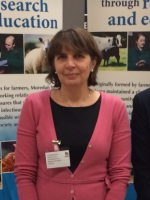
Work Package Agricultural systems and land management
Introduction
The One Health initiative is a global movement that unites animal, plant and human health. Our role in this initiative is to investigate the importance of the environment in disease transmission and host susceptibility to improve risk prediction and ultimately disease control. This aligns with the UK Animal and Plant Health Agency (APHA) strategy and will contribute towards the vison for capacity building and further integration. A disease systems approach will focus on biological processes and management practices that drive disease dynamics, persistence and spread, and is particularly relevant for parasites and pathogens with an environmental element to their lifecycle. Pest, parasites and pathogens of plants, animals and humans will be included, all of which are priorities of the stakeholder community. We bring together science disciplines and stakeholders for improved understanding of the patterns of infection seen in agricultural environments. In doing so, we highlight the contribution of disease control by addressing the global grand challenges of:
• Climate change: contribution to & consequence of animal health
• Food Security: protecting production efficiency
• Disease Control: from emergence to emergency
Aim of Research
Disease Threats in the Environment: Investigate the importance of the environment in disease transmission and host susceptibility to improve risk prediction and ultimately disease control. This aligns with the UK Animal and Plant Health Agency (APHA) strategy and will contribute towards the vison for capacity building and further integration. The work is split into four main objectives: (1) wildlife ecology; (2) the impact of farm management practices on disease risk; (3) a role for the environment on disease transmission; and (4) systems approaches for disease control.
Progress
Despite normal working being interrupted by the COVID-19 pandemic progress was made in a number of different areas
Highlights
- Behavioural signatures of early parasitism: Targeted selective treatment, when only parasite infected animals are treated with drugs, is a strategy to reduce overall drug use in livestock and thus limit the development of drug resistance. The challenge is to identify animals requiring treatment as early as possible, to limit the production impacts of infection. Natural sickness behaviours affecting animal activity behaviour can be continuously monitored with new technology, and changes in levels of animal activity occurred within a week of parasite exposure, and well before infection induced reductions in liveweight gain. Recent advances in continuous livestock monitoring systems combined with high behavioural sensitivity to infection offer new ways to target animals for treatments.
- Summarising over 20 years of research into Paratuberculosis. The SEFARI team were invited to summarise the Scottish Government funded research in Paratuberculosis: Organism, Disease, Control, and contribute to the book of the same name. Topics included the role of rabbits in the epidemiology of paratuberculosis in cattle, and the genetics of paratuberculosis strains across its broad host species range.
- Generative models of network dynamics provide insight into the effects of trade on endemic livestock disease: Livestock movement between farms is a key mechanism driving disease spread and persistence, however they are necessary to farm businesses. We developed the first generative modelling framework for livestock movements that accounts for key features of complex national scale real-world systems. Analysis of resulting between-farm disease spread shows changes to trading patterns that conserve farm-level in-flow of animals (i.e. business continuity) provide a powerful approach to control of endemic disease. Further work is needed to explore potential incentives for behaviour change (e.g. cooperatives, health schemes) and identify potential barriers to uptake. However, reductions in disease burden resulting from targeted modification of trade practices scale much more favourably than those associated with improvements to farm biosecurity that are the usual focus of disease control policies.
A wide range of work has continued to monitor and assess the risk of pathogens associated with wildlife or environmental habitats. The work spans large-scale surveillance, e.g. for tick-borne diseases, to parasite carriage in wildlife and farmed animals, pathogen resistance and prevalence on plant crops, animal behaviour related to health status, plant-microbe interaction for foodborne pathogens and the potential for transmission of antibacterial resistance genes. Some of the highlights include:
Resistance to change: Antimicrobial administration is used to control disease in livestock, but there is little insight into how this impacts antimicrobial resistance (AMR) gene dynamics. A highly detailed on-farm AMR study on a commercial pig unit found a large number of AMR genes, and that their prevalence and abundance were not influenced by antibiotic use. Certain genes appear to be widely disseminated. However, the main antimicrobials continue to control diseases in production despite the high and relatively stable levels of resistance genes against them.
Multi-host disease management - the why and the how to include wildlife: Outbreaks caused by multi-host pathogens have posed a serious challenge to public and animal health authorities. To face challenges of insufficient guidance for mitigating these diseases within wild animal populations and the assumptions implicating wildlife, decision making tools for disease management have been generated with European policy makers. These will be used by public and health authorities and act as an initial step towards a harmonized transboundary outbreak response.
New disease threats in cereals: Resistance management advice on new variants of endemic pathogens of cereals has been prepared in collaboration with the Fungicide Resistance Action Group (FRAG-UK). A disease compendium has been generated for use at SAC Consultant training days and in BASIS teaching to aid identification skills and also to aid estimation of thresholds for treatment.
In Year 3, we consolidated previous data and acquired additional data towards four main objectives. Work on wildlife ecology found that deer sex and health may be an indicator for tick carriage, and that a significant proportion of wild rabbits carry the parasite Cryptosporidium. To better understand the impact of farm management practices on disease risk, a combination of modelling and primary data acquisition were carried out for a range of diseases and risks including parasite carriage in sheep and the risk of AMR transfer within farms. Disease transmission between farms was assessed using modelling approaches. A role for the environment on disease transmission focused on E. coli O157:H7 bacteria genes that play a role in colonisation of plants, in particular, those that are secreted into the plant host. In systems approaches for disease control, work covered cattle and plant diseases. Both areas have focused on surveillance and detection approaches, but by quite different means: using collars to monitor animal health, or by screening plants for pathogen presence.
Highlights:
- Contributions to the wider scientific community included joining a Steering Group for an initiative on the Plant Microbiome, run by Rothamsted and CABI
- A keynote presentation was given at the ICPP meeting (August 2018, Boston) on the role of plant pathology in food safety (http://www.icpp2018.org/Pages/default.aspx), linked to RD3.1.3
- Combatting agriculture’s contribution to climate change: Gastrointestinal helminths (parasitic worms) are globally ubiquitous and represent one of the most pervasive challenges to the health and productivity of grazing livestock. These parasites influence a number of factors affecting methane emissions including feed efficiency, nutrient use, and production traits. This is the first study that empirically demonstrates disease-driven increases in methane (CH4) yield in livestock (grams of CH4 per kg of dry matter intake). We showed that parasite infections in lambs can lead to a 33% increase in methane yield (g CH4/kg DMI). This knowledge will facilitate more accurate calculations of the true environmental costs of parasitism in livestock, and reveals the potential benefits of mitigating emission through controlling parasite burdens.
- When to kill a cull: factors affecting the success of wildlife disease control. Wildlife population reduction to control disease can lead to both decreases and increases in disease levels, with apparently conflicting responses observed, even for the same wildlife-disease system. WP2.3.3 modelling studies of wildlife disease dynamics showed that if population reduction is too low, or has limited coverage, a ‘perturbation effect’ is observed, whereby culling leads to increased wildlife movement and disease prevalence and spread. The results also demonstrate the importance of culling across appropriate timescales, with otherwise successful control strategies leading to increased disease if they are not implemented for long enough. These results potentially explain a number of observations of the dynamics of both successful and unsuccessful attempts to control TB in badgers including the Randomised Badger Culling Trial in the UK, highlighting their policy relevance.
Environmental sources of transmission of pathogens are diverse, requiring a wide range of approaches to understand the issues. We are investigating both animal and human diseases transmitted via managed (farm) and unmanaged (wildlife) situations, covering plant and animal hosts / vectors. Approaches including modelling, biometrics, epidemiology and basic science to generate data relating to farm management practices, prevalence of pathogens in wildlife reservoirs, interactions of pathogens with secondary hosts and animal or plant health. Some objectives are cross-institutional, to maximise available expertise and resources. By its nature, this research deliverable has multiple dependencies with other deliverables, and has proven to be an exemplar for inter-disciplinary, cross-institute collaborations.
Highlights:
- Collective work across RDs and Themes brought together a themed work on antimicrobial resistance. This has led to the initiation of a series of workshops (the first held on 10th Nov 2017, Dundee), to coordinate the work and provide a stronger, more visible platform for stakeholders (policy; industry; science) in one of the highest priority areas.
- Collaborative efforts with EPIC have identified environmental risk factors for tick-borne disease discovering that tick-borne Louping-ill Virus is more prevalent among Scottish sheep if the farms are situated in more marginal, moorland areas (in contrast to lowland improved grassland), and areas with higher densities of deer (the main tick host). This can inform policy on land, wildlife and livestock management strategies and publications are in preparation.
- A plant health review showed that although wet weather is a known risk factor, pesticide inputs are not moderated between seasons to reflect that risk. In addition, there is a lag in the identification in commercial crops for new and emerging pathogens (as identified on trial plots), which is as much as 8 years for ramularia. Fungicide stewardship guidelines and information at https://cereals.ahdb.org.uk/frag and a series of popular articles in the technical press including Scottish Farmer, Crop Production Magazine, Farmers Weekly and Farmers Guardian.
- Alternative parasite control strategies: Gastrointestinal parasites are a ubiquitous and pervasive challenge to grazing livestock systems. Anthelmintics remain the mainstay of parasite control strategies but resistance is increasing with reported levels on Scottish sheep farms of 64%. We continue to undertake research into alternative parasite control strategies to reduce the reliance on anthelmintics, slow the progress of resistance to them and prolong their effective lifespan including: (i) use of bioactive forages with anti-parasitic effects, (ii) protein supplementation to boost immunity and (iii) identifying animals that benefit most from anthelmintic treatments (e.g. based on live weight and sickness behaviours). The farming community has been exposed to the results via SEFARI Gateway knowledge exchange networks and events. A recent survey of UK sheep farms (N=227, EU PROPARA project) showed widespread farmer awareness of alternative parasite control strategies - 57% had tried and 30% had applied the bioactive forages; 70% had tried and 50% had applied protein supplementation and 83% had tried and 62% had applied TST strategies. These UK uptake figures were as high and often higher, up to double, to those of other countries and indicate farmer uptake and evidence of the impact of Scottish research in parasite control.
This project investigates the role of the environment in disease transmission, by focusing on strategically and economically important diseases. We encompass a range of plants and animal diseases that include an environmental component, covering bacteria, fungi, viruses and in some cases, their vectors. The project has inherent linkages with multiple other projects since it cuts across a variety of themes and disciplines. It fits firmly into the remit of ‘One Health’, recognising the interconnectedness of systems and resulting impact on health and disease, putting the approaches and the outputs at the leading edge.
Highlights:
- Improving Capabilities in Livestock & Wildlife Disease Management: WP2.3.3 developed new epidemiological tools and critical insights into disease surveillance. This work provides: tools to design better wildlife disease surveillance, showing that the power of existing surveillance systems to detect disease is, in many cases, overestimated; ‘hindcasting’ methods that exploit currently underused characteristics of disease diagnostic tests to recover epidemic trends not otherwise apparent when outbreaks are first detected; modelling results showed that for many wildlife disease systems fluctuations in population size and disease lead to bias in surveillance based estimates of prevalence and reduce the power to detect disease. Neglecting these ecological effects leads to incorrect assessments of the risks posed by disease in wildlife. A new epidemiological statistic (R*) was developed that quantifies between farm disease transmission and is an important addition to the tools available to epidemiologists for disease control in livestock systems SEFARI scientists are continuing to develop these tools to better assess surveillance of wildlife disease, fully exploit disease diagnostics and better understand the impact of animal movements on endemic livestock disease.
Future Activities
In the concluding year, we will finalise experimental and field research, as well as use the modelling frameworks developed, and data sets collected, during the Programme on topics including behavioural signatures of parasitism, role of livestock trade in disease persistence and spread, and alternative parasite control strategies. Using the systems approach, the project will also consider new technologies that provide win wins in disease control, improved animal welfare, reduced environmental pollution, and the circular economy associated with reduced microbial activity in livestock production systems.
Selected Outputs
- Research publication showing that microgreens pose a potential microbial hazard for Shigatoxigenic E. coli contamination (https://doi.org/10.1016/j.ijfoodmicro.2018.02.025)
- Prentice, J.C., Fox, N.J., Hutchings, M.R., White, P.C.L., Davidson, R.S. & Marion, G. (2019) When to kill a cull: factors affecting the success of culling wildlife for disease control. Journal of the Royal Society Interface 16 (152), 20180901
- Fox, N.J., Smith, L.A., Houdijk, J.G.M., Athanasiadou, S. & Hutchings M.R (2018). Ubiquitous parasites drive a 33% increase in methane yield from livestock. International journal for parasitology 48 (13), 1017-1021
- Fox, N.J., Caldow, G.L., Liebeschuetz, H., Stevenson, K., & Hutchings, M.R. (2018). Counterintuitive increase in observed Mycobacterium avium subspecies paratuberculosis prevalence in sympatric rabbits following the introduction of paratuberculosis control measures in cattle. The Veterinary Record, 182 (22), 634.
- Gerrard, Z.E, Swift, B.M.C., Botsaris, G., Davidson, R.S., Hutchings, M.R., Huxley, J.N., Rees, C.E.D. (2018). Survival of Mycobacterium avium subspecies paratuberculosis in retail pasteurised milk. Food Microbiology, Food Microbiology 74, 57-63.
- Pollock, J., Gally, D.L., Glendinning, L., Tiwari, R., Hutchings, M.R. & Houdijk J.G.M. (2018). Analysis of temporal fecal microbiota dynamics in weaner pigs with and without exposure to enterotoxigenic Escherichia coli. Journal of Animal Science 96 (9), 3777-3790
- Houdijk J.G.M., Tolkamp, B.J., Rooke, J.A. & Hutchings, M.R. (2017). Animal health and greenhouse gas intensity: the paradox of periparturient parasitism. International Journal for Parasitology, 47 (10-11), 633-641.
- Prentice, J.C., Marion, G., Hutchings, M.R., McNeilly, T.N. & Matthews, L. (2017). Complex responses to movement based disease control: when livestock trading helps. Journal of the Royal Society Interface, 14, 20160531.
- Pritchard, T.C., Coffey, M.P., Bond, K.S., Hutchings, M.R. & Wall, E. (2017). Phenotypic effects of subclinical paratuberculosis (Johne’s disease) in dairy cattle. Journal of Dairy Science, 100, 679-690.
- Rydevik, G., Innocent, G.T., Marion, G., Davidson, R., White, PCL., Billinis, C., Barrow, P., Mertens, P.C., Gavier-Widén, D., Hutchings, M.R. (2016). Using combined diagnostic test results to hindcast trends of infection from cross-sectional data. PLoS Computational Biology, 12(7): e1004901. doi:10.1371/journal.pcbi.1004901
- Walton, L., Marion, G., Davidson, R., White, P.C.L., Smith, L., Gavier-Widen, D., Yon, L., Hannant, D., Hutchings, M.R. (2016). The ecology of wildlife disease surveillance: demographic and prevalence fluctuations undermine surveillance. Journal of Applied Ecology, 53, 1460-1469.
- Pollock, J., Muwonge, A., Hutchings, M.R., Mainda, G., Bronsvoort, B.M., Gally, D.L., Corbishley, A. (2020). Resistance to change: AMR gene dynamics on a commercial pig farm with high antimicrobial usage. Scientific Reports 10 (1), 1-10 https://www.nature.com/articles/s41598-020-58659-3
- Portier, J., Ryser-Degiorgis, M.P., Hutchings, M.R., Monchâtre-Leroy, E., Richomme, C., Larrat, S., Van Der Poel, W.H.M., Dominguez, M., Linden, A., Tavares Santos, P., Warns-Petit, E., Chollet, J.Y., Cavalerie, L., Grandmontagne, C., Boadella, M., Bonbon, E., Artois, M. (2019). Multi-host disease management: the why and the how to include wildlife. BMC Veterinary Science 15, 1-11. https://doi.org/10.1186/s12917-019-2030-6
- Smith, LA Swain, DL., Innocent, GT., Nevison, I., Hutchings MR. (2019). Considering appropriate replication in the design of animal social network studies. Scientific reports 9 (1), 7208 https://doi.org/10.1038/s41598-019-43764-9
- Pollock, J., Hutchings, MR, Hutchings, KEK, Gally, DL Houdijk, JGM (2019). Changes in the ileal, but not fecal, microbiome in response to increased dietary protein level and enterotoxigenic Escherichia coli exposure in pigs. Applied and Environmental Microbiology, AEM. 01252-19 10.1128/AEM.01252-19
- Holmes A, Pritchard L, Hedley P, Morris J, McAteer SP et al. (2020) A high-throughput genomic screen identifies a role for the plasmid-borne type II secretion system of Escherichia coli O157:H7 (Sakai) in plant-microbe interactions. Genomics https://doi.org/10.1016/j.ygeno.2020.07.021
- Holmes A, Pritchard L, Hedley P, Morris J, McAteer SP et al. (2020) Dataset of Escherichia coli O157: H7 genes enriched in adherence to spinach root tissue. Data Brief 2020;31:105769. DOI: 10.1016/j.dib.2020.105769
- Guidance has been provided for fungicide resistance management in cereals: https://ahdb.org.uk/frag-cereals
- Knight, M.A., White, P.C.L., Hutchings, M.R., Davidson, R.S., Marion, G. (2021). Generative models of network dynamics provide insight into the effects of trade on endemic livestock disease. Royal Society Open Science 8 (3), 201715
- Fox, N.J., Smith, L.A., Stevenson, K., Davidson, R.S., Marion, G., Hutchings, M.R. (2020). Infection of Non-Ruminant Wildlife by Mycobacterium avium Paratuberculosis. Paratuberculosis: Organism, Disease, Control, 200. CABI.
- Shrestha, S., Barratt, A.S., Fox, N.J., Ahmadi, B.V., Hutchings, M.R. (2020). Financial impacts of liver fluke on livestock farms under climate change - a farm level assessment. Frontiers in Veterinary Science, 7










